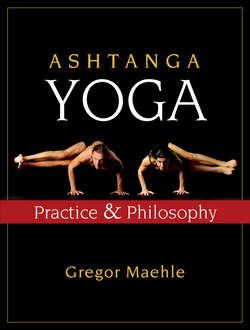Читать книгу Ashtanga Yoga - Gregor Maehle - Страница 203
На сайте Литреса книга снята с продажи.
Vinyasa Nine
ОглавлениеExhaling, fold forward at the hip joints, maintaining the lift created in vinyasa eight. Rather then collapsing the head down toward the knees, lift the heart forward toward the toes.
The work of Uddiyana Bandha is important here to support the low back. Do not breathe excessively into the belly, as is often done in forward bending, but encourage the rib cage to participate in the breathing process.
The inhalation is used to reach the heart forward, whereas the exhalation is used by surrendering deeper into the posture. If this instruction leads to the student “bouncing” up and down in the posture, we can conclude that Uddiyana Bandha is not engaged sufficiently. Let these movements be motivated from deep within, working the posture from the core out toward the periphery.
The kneecaps are permanently lifted in all forward-bending postures. As explained in Padangushtasana (page 37), the antagonist of each muscle to be stretched needs to be engaged. The muscle group being stretched here is the hamstrings; their antagonist is the quadriceps. For beginners it is often impossible to keep the kneecaps pulled up due to an inability to access the quadriceps. It may seem as if we need to grow a new nerve connection to this muscle. This learned coordination is possible through concentration and perseverance. The teacher may gently press the thumbs into both thighs to “awaken” the quadriceps.
In all forward bends it is important to release and spread the buttocks. The buttocks are often tightened in a fear response to the stretch felt. Tightening the buttocks, however, draws us up out of the forward bend since the gluteus maximus muscle is a hip extensor. The ligaments of the sacroiliac joints (sacrum/pelvis joints) can also be strained. Focus on releasing the buttocks, allowing them to spread, and lengthen through the low back. This is eccentric lengthening of the quadratus lumborum muscle. Eccentric lengthening means that the muscle is active, as we need it to keep the back straight, but at the same time it becomes longer as we elongate the waist. In other words the muscles lengthen against resistance. It is important to create additional space between the hipbone and the lowest rib because a shortened, contracted waist is an obstacle in all forward bending, backbending, and leg-behind-head postures.
